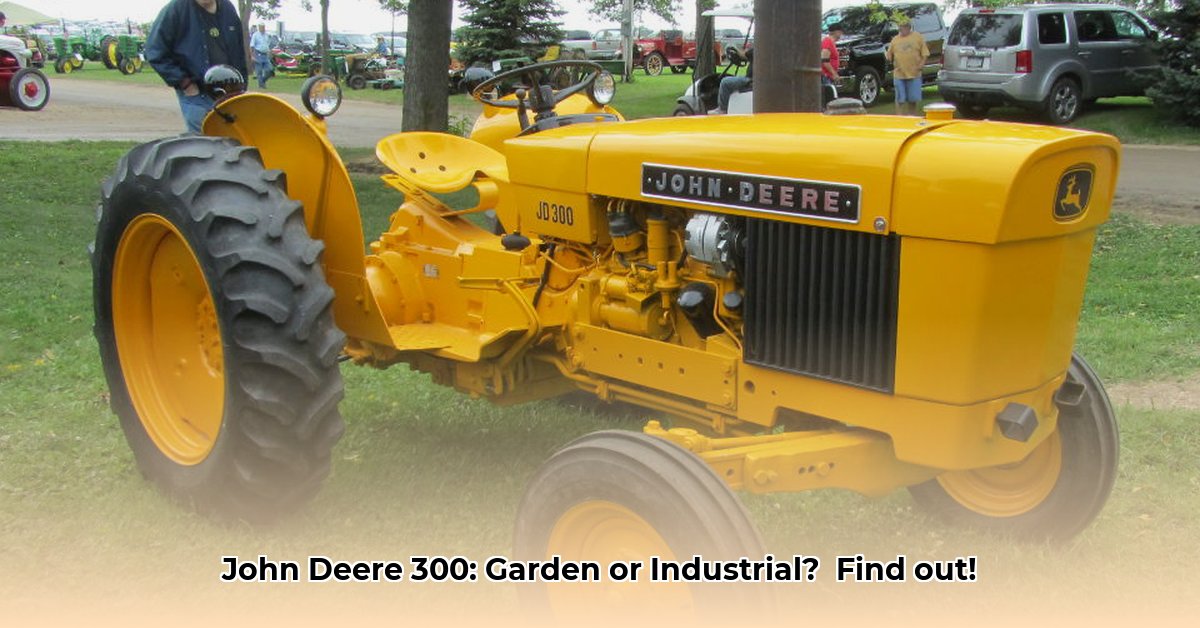
The John Deere 300 tractor, a name synonymous with agricultural dependability, actually encompasses two distinct machines: a garden tractor and a more robust industrial model. While both share the iconic John Deere green, their capabilities and intended applications differ significantly. This comparison explores the key distinctions between these two versions, helping you determine which model best suits your needs. For more powerful options, check out the John Deere 850.
Under the Hood: Power and Performance Differences
The most striking difference lies in the powertrain. The John Deere 300 garden tractor, designed for smaller properties and lighter tasks, typically employs a 16-horsepower Kohler gasoline engine. This provides ample power for lawn mowing, light ground-moving, and other yard work. But is a 16 horsepower engine enough for your needs? Consider the size of your property and the types of tasks you plan on undertaking.
The industrial model, however, boasts significantly more power. Engine options include a substantial 43-horsepower 2.5-liter three-cylinder diesel engine, or a 2.2-liter three-cylinder gasoline alternative. This increased horsepower allows for heavier workloads and extended operating times, making it ideal for larger-scale agricultural operations. This significant horsepower difference reflects the different tasks each model was engineered to perform.
Transmission Technology: Control and Maneuverability
Both garden and industrial models are equipped with two-wheel drive systems; however, the transmission technology differs considerably. The garden tractor utilizes a hydrostatic transmission – a system that controls speed via a lever, offering smooth and easy maneuverability, perfect for navigating smaller spaces. The simplicity of this system perfectly aligns with the garden model's intended use.
Conversely, the industrial model typically features a more sophisticated 8-speed constant mesh or power shuttle transmission. This provides operators with greater control over speed and power, essential for efficient performance across a range of agricultural tasks. The increased complexity reflects the greater precision required for heavier, more demanding operations. This difference enhances control and efficiency in industrial applications.
Attachments and Implements: Expanding Capabilities
The variety of available attachments further highlights the functional differences between these two models. The garden tractor accepts a range of implements, including various mowing decks (38-inch and 46-inch), snow blowers, grading blades, front-end loaders, and even backhoes. This versatility makes it a practical choice for homeowners requiring a multi-purpose machine for various outdoor tasks. How many of these attachments are essential to your needs?
The industrial model's capabilities are significantly amplified by an optional mid-PTO (power take-off) operating at 1000 RPM. This allows it to power larger and more specialized implements, such as hay balers, tillage equipment, and other heavy-duty agricultural tools. This is the key component that elevates the industrial model's functionality for professional agricultural purposes. The larger, heavier-duty attachments possible with the PTO reflect the tractor's industrial-grade design.
Manufacturing Location: Reflecting Target Market
Even the manufacturing locations reflect the target markets for each model. The John Deere 300 garden tractor was produced in Horicon, Wisconsin, strategically positioned to serve residential and light-commercial users in the region and beyond. Its design and functionality are perfectly suited for the average homeowner.
The industrial version, on the other hand, was manufactured in Dubuque, Iowa, an area known for its agricultural significance. This location showcases the tractor's suitability for larger farming operations in the region and nationwide. The proximity to agricultural hubs reflects the intended usage of this more powerful, heavy-duty machine.
John Deere 300 Tractor: A Concise Comparison
| Feature | John Deere 300 Garden Tractor | John Deere 300 Industrial Tractor |
|---|---|---|
| Engine Power | 16 hp Kohler Gasoline | 43 hp 2.5L 3-cyl Diesel or 2.2L 3-cyl Gasoline |
| Transmission | Hydrostatic | 8-speed Constant Mesh or Power Shuttle |
| Power Take-Off (PTO) | None | Optional Mid-PTO (1000 RPM) |
| Typical Use | Home, light commercial | Large-scale agriculture |
| Manufacturing Location | Horicon, WI | Dubuque, IA |
In conclusion, the John Deere 300 isn't a single machine but rather a family of tractors tailored to distinct needs. The garden and industrial models represent John Deere's adaptability in meeting both residential and professional agricultural demands. Choosing between the two hinges on your individual requirements and the scale of your operations.